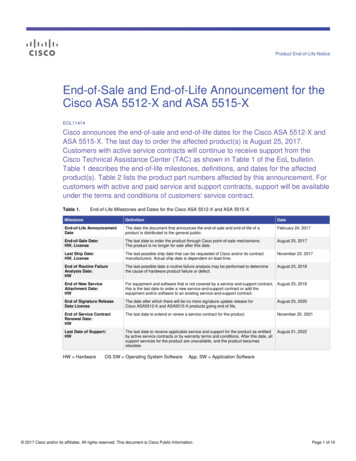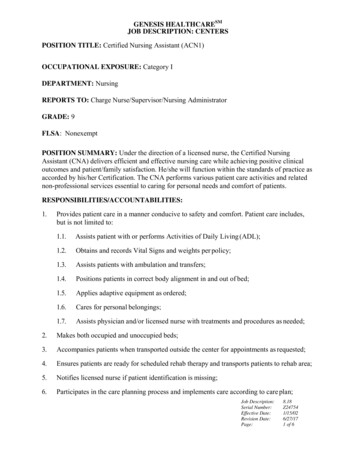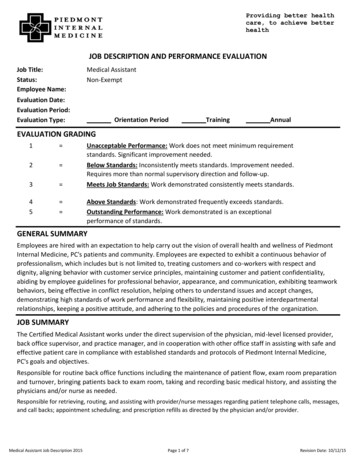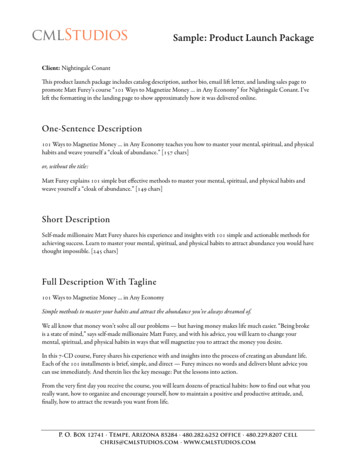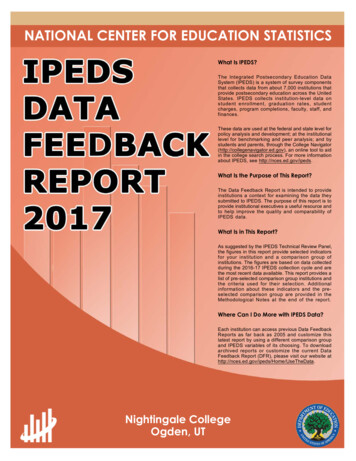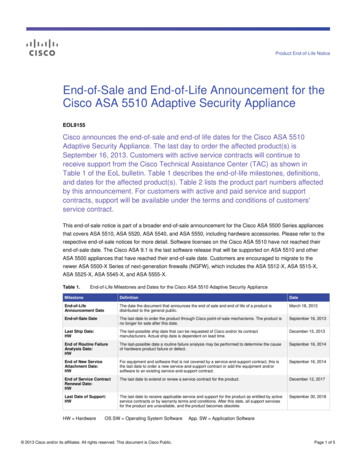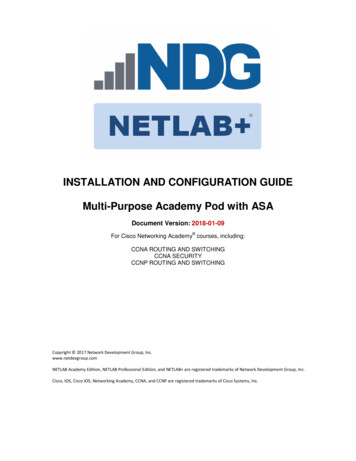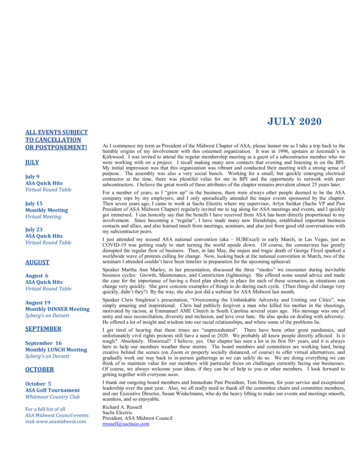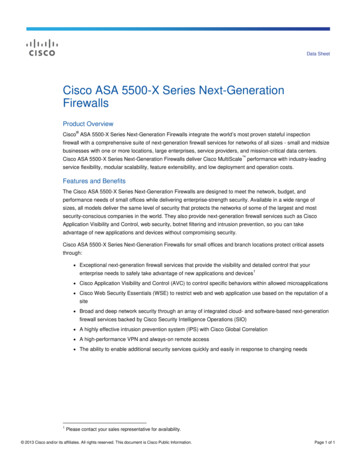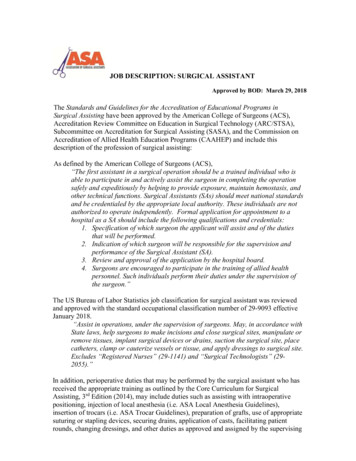
Transcription
JOB DESCRIPTION: SURGICAL ASSISTANTApproved by BOD: March 29, 2018The Standards and Guidelines for the Accreditation of Educational Programs inSurgical Assisting have been approved by the American College of Surgeons (ACS),Accreditation Review Committee on Education in Surgical Technology (ARC/STSA),Subcommittee on Accreditation for Surgical Assisting (SASA), and the Commission onAccreditation of Allied Health Education Programs (CAAHEP) and include thisdescription of the profession of surgical assisting:As defined by the American College of Surgeons (ACS),“The first assistant in a surgical operation should be a trained individual who isable to participate in and actively assist the surgeon in completing the operationsafely and expeditiously by helping to provide exposure, maintain hemostasis, andother technical functions. Surgical Assistants (SAs) should meet national standardsand be credentialed by the appropriate local authority. These individuals are notauthorized to operate independently. Formal application for appointment to ahospital as a SA should include the following qualifications and credentials:1. Specification of which surgeon the applicant will assist and of the dutiesthat will be performed.2. Indication of which surgeon will be responsible for the supervision andperformance of the Surgical Assistant (SA).3. Review and approval of the application by the hospital board.4. Surgeons are encouraged to participate in the training of allied healthpersonnel. Such individuals perform their duties under the supervision ofthe surgeon.”The US Bureau of Labor Statistics job classification for surgical assistant was reviewedand approved with the standard occupational classification number of 29-9093 effectiveJanuary 2018.“Assist in operations, under the supervision of surgeons. May, in accordance withState laws, help surgeons to make incisions and close surgical sites, manipulate orremove tissues, implant surgical devices or drains, suction the surgical site, placecatheters, clamp or cauterize vessels or tissue, and apply dressings to surgical site.Excludes “Registered Nurses” (29-1141) and “Surgical Technologists” (292055).”In addition, perioperative duties that may be performed by the surgical assistant who hasreceived the appropriate training as outlined by the Core Curriculum for SurgicalAssisting, 3rd Edition (2014), may include duties such as assisting with intraoperativepositioning, injection of local anesthesia (i.e. ASA Local Anesthesia Guidelines),insertion of trocars (i.e. ASA Trocar Guidelines), preparation of grafts, use of appropriatesuturing or stapling devices, securing drains, application of casts, facilitating patientrounds, changing dressings, and other duties as approved and assigned by the supervising
surgeon and local facility.Facilities that employ surgical assistants, should identify the specific surgical assistantjob description and/or credentialing process ensuring that the hospital medical staff hasreviewed and approved such document. In addition, the facility should ensure that theindividual has acquired and maintains the appropriate training (i.e. continuing education)and credentialing as outlined by national standards. If employed by the facility, the sizeof the operating room team should not be reduced; the facility policy with local surgeoninput should identify procedures or situations in which the Surgical Assistant should notsimultaneously function in the scrub role when serving as the first assistant. Examplesmay include procedures such as arthroplasty, open heart, laminectomy, etc.EducationSurgical assistants who complete their examination through the NBSTSA graduate fromsurgical assisting programs accredited through ARC/STSA, a collaborative effort ofASA, ACS, and SASA, by CAAHEP. CAAHEP is a recognized accreditation agency ofthe Council for Higher Education Accreditation (CHEA). In addition, surgical assistingprograms are located in educational institutions that are institutionally accredited byagencies recognized by the United States Department of Education (USDE), The JointCommission, or a state agency acceptable to CAAHEP and the ARC/STSA. TheARC/STSA is also a member of the Association of Specialized and ProfessionalAccreditors (ASPA).New practitioners wishing to obtain the Certified Surgical Assistant (CSA) credentialfrom the National Commission for the Certification of Surgical Assistants (NCCSA)may need to complete alternate or additional requirements and should contact thatagency to verify if their school/program has been accredited.CredentialsCertification is conferred by the National Board of Surgical Technology and SurgicalAssisting (NBSTSA). Currently, initial certification as a Certified Surgical FirstAssistant (CSFA) is based upon graduation from a CAAHEP-accredited school ofsurgical assisting followed by satisfactory performance on the national CertifiedSurgical First Assistant examination. CSFAs maintain their certification by earningapproved continuing education or by successfully retaking the certifying examination atthe conclusion of the renewal period. Any other circumstances or previously acceptedpathway to an accredited certification such as on-the-job training who continued tomaintained their accredited credential remain in good standing.New practitioners wishing to obtain the Certified Surgical Assistant (CSA) credentialfrom the National Commission for the Certification of Surgical Assistants (NCCSA)may need to complete alternate or additional requirements and should contact theagency to verify if their school/program has been accredited.The NBSTSA’s certification program is accredited by the National Commission forCertifying Agencies (NCCA), the accreditation division of the Institute forCredentialing Excellence (ICE) and is in compliance with NCCA’s Standards for the
Accreditation of Certification Programs. NCCA standards and accreditation services arereferenced requirements in state and federal legislation pertaining to personnelcertification. ICE is accredited by the American National Standards Institute (ANSI) asa Standards Developer. ICE’s accrediting body, the NCCA, evaluates certificationorganizations for compliance with the NCCA Standards for the Accreditation ofCertification Programs. NCCA’s Standards exceed the requirements set forth by theAmerican Psychological Association and the U.S. Equal Employment OpportunityCommission.Professional OrganizationsThe Association of Surgical Assistants professional organization represents the interests ofover 5,000 surgical assistants. ASA works cooperatively with other organizations in thesurgical assistant community to promote legislation and other endeavors that foster thegrowth of this developing profession.The primary purpose of ASA is to ensure that surgical assistants have the knowledge andskills set to provide optimal patient care and offer continuing education. The current CoreCurriculum for Surgical Assisting, 3rd Edition, (2014) provides guidance to all CAAHEPaccredited schools. ASA collaborates with ARC/STSA and NBSTSA to set standards foreducation and certification and represents the profession at the state and national levels.Role of the Surgical AssistantThe role of the surgical assistant is vital to the operating room and any surgical casewithin the operating suite. The surgical assistant provides immediate support to thesurgeon and should act as a vital resource to the staff of the Operating Room suite. Thesurgical assistant should be knowledgeable, well rounded, helpful, and supportive of ateam like attitude. The surgical assistant is a necessary source of knowledge and skills.This role is further defined as follows;1. General Surgical Assistant Skills:A. Demonstrate the ability to communicate the surgeon’s preferences and specificpatient’s needs to surgical team including but not limited to suture needs,specialty supplies and instrumentation, and equipment.(1) Verifies all implants, supplies and special procedure equipment isavailable and functional. (i.e. microscope, tourniquet, etc.)(2) Facilitates a cooperative team atmosphere through professionalcommunication.(3) Listens actively to surgeon, patient and team to ensure safe patientcentered care.(4) Maintains awareness of patient monitoring and responds appropriatelyto potential complications.B. Demonstrate the ability to apply advanced knowledge of normal and pathologicalsurgical anatomy and physiology.(1) Describes the assessment and management of acute trauma.(2) Responds appropriately to emergency conditions.C. Demonstrates Aseptic Skills:(1) Monitors the actions immediately surrounding the sterile field ensuringthat the integrity is maintained and/or corrected appropriately.(2) Evaluates potential causes of surgical site infections, communicatingconcerns and possible corrective actions to prevent and/or treatpotential contamination.
D. Acquires continuing education annually to maintain current competence andcredential regarding specific skills and techniques including aseptic technique.Bases decisions on research-based evidence.E. Participates in the education of allied health personnel including SA and STstudents.2. Preoperative Role:A. Demonstrates the ability to provide preoperative skills such as assessing patientinformation, history, preoperative tests (i.e. EKG, EEG, EMG, lab values,diagnostic imaging), safety measures, biopsy results, positioning and draping.(1) Verifies patient identification, allergies, NPO status, procedure, surgicalsite, consent, history and physical on chart.(2) Inspects skin integrity for signs of infection, compromised perfusion orother signs of potential risk.(3) Ensures x-rays and applicable diagnostic exams are available forsurgeon.B. Specifics regarding positioning the patient:(1) Ensures placement of monitoring devices does not interfere with access(2)(3)(4)(5)or prep.Ensures position of the patient provides the necessary exposure for theprocedure, as well as the surgeon preference.Demonstrates competency in all positioning techniques for the surgeriesthey are participating in. These competencies include, but are notlimited to;a. Prevention of nerve damageb. Proper rotation of extremitiesc. Prevention of circulatory or respiratory compromise.d. Prevention of patient sliding on bed due to tilting orTrendelenburg.e. Proper handling and placement of lines.Demonstrates safe stabilized placement on the appropriate bed/table,with the appropriate operation, set up, safety measures, and utilizationof all necessary equipment, stabilizers, padding, wrapping and/orattachments.Maintains knowledge of new or upgraded positioning equipment,supplies and positioning techniques through continuing education.C. Specifics regarding surgical skin prep:(1) Ensures safe placement of tourniquet, extremity padded correctly,safety precautions followed and the accuracy of the settings fortourniquet inflation.(2) Ensures skin prep will provide the necessary exposure for the surgicalprocedure, any possible drain sites and/or possible extension(s) of theoperative incision, as well as surgeon preference:a. Facilitates clipping or trimming of hair in preop holding andonly if necessaryb. Demonstrates ability to perform a surgical skin prep selectingthe correct prep for the situation (i.e chlorhexidinegluconate/alcohol prep, iodine povacrylex/alcohol prep,chlorahexidine gluconate, povidone-iodine (iodopovidone),etc.) and preparing the appropriate surgical prep sitenecessary.
c.Demonstrates insertion of foley catheter; prevents potentialcomplications, as indicated.B. Specifics regarding draping:(1) Streamlines the establishment of the sterile field.(2) Coordinates the draping procedure effectively correcting any breaks inaseptic technique.(3) Supports double gloving/changing outer gloves after establishment ofthe sterile and periodically (every 90 minutes) during case.(4) Secures lines and cords in a manner that prevents loss of integrity.(5) Evaluates and incorporates products to ensure effective barriers areestablished and maintained that prevent contamination during the entireprocedure.3. Intraoperative Care:A. Demonstrates the ability to provide intraoperative skills such as visualization,trocar insertion (i.e. ASA Trocar Guidelines), injection of local anesthetics (i.e.ASA Local Anesthesia Guidelines), hemostasis, tissue handling, placement andsecuring of wound drains, and closure of body planes.B. Utilizes the OR equipment pertinent to the surgical procedure. All actions shallfacilitate the progress of the surgery, as well as anticipate the preference(s) of thesurgeon. This shall include, but not be limited to:(1) Hemostatic equipment and supplies, including monopolar, bipolar,harmonic scalpel, ultrasonic, medications, sponges, etc. Includesappropriate safety precautions such as the placement of grounding pad,assists scrub and circulator with accuracy of counts when necessary,etc.(2) Knowledge of and use of any and all laparoscopic and roboticequipment necessary for a procedure, such as: Camera, light cord,inserting/removing trocars, graspers, scoops, sprayers, suction/irrigationsystems, clamps, tenaculums, etc.(3) Knowledge of and use of any open procedure equipment necessary forprocedures, including, tissue forceps, retractors, clamps, scissors,sponges, suction, irrigation, use of hemostatic agents, etc.(4) Any further applicable instrumentation or actions deemed necessary bythe surgeon.C. The surgical assistant should be proficient in all pertinent abilities required duringa procedure. These shall follow any necessary and appropriate methods applicableto the procedure, as well as surgeon preference. These shall include, but not belimited to;(1) Clamping, cauterizing, suturing, inserting, injecting, manipulating,retracting, cutting, and ligating tissue as necessary(2) Any necessary involvement in hemostasis, including but not limited tothe utilization of ties, vessel loops, clip appliers, digital pressure,packing, appropriate manipulation of sutures, etc.(3) Participation in volume replacement or autotransfusion techniques asnecessary and appropriate.(4) Any further applicable instrumentation or actions deemed necessary bythe surgeon.D. The surgical assistant should be capable of working independently, or codependently with the surgeon, to finalize the surgery, according to the surgeonpreference. These actions shall include, but are not limited to;
(1) Participates in quality improvement process that include standardized(2)(3)(4)(5)(6)(7)approaches, checklist interventions such as the Michigan KeystoneSurgery Project regarding surgical site infection to improve patient careand Time Out procedures to improve patient safety.Initiates appropriate actions or instrumentation in collaboration with thesurgeon.Utilizes appropriate suturing techniques, according to surgeonpreference, with closure of body planes and utilizing propermanipulation of suture.a. Using running, or interrupted suture techniquesb. Including absorbable and non-absorbable sutures, staples,adhesives, strips, etc.Demonstrates ability to administer local anesthetic, according tosurgeon preference.Demonstrates ability to secure drainage systemsDemonstrates ability to apply dressings, splints, casts and immobilizers/stabilizers, according to surgeon preference.Evaluates the patient for any possible damage from positioning. Thisshall include a skin assessment. Any abnormal condition should bereported to the surgeon, and appropriate treatment be carried outaccording to surgeon instruction.4. Postoperative Care.A. Demonstrates the ability to provide postoperative skills in patient care such asdressing application, patient transfer and transport, transfer of care, andmonitoring for immediate complications.B. Collaborates with others to provide continuity of care.ReferencesCore Curriculum for Surgical Assisting. 3rd Edition. Association of Surgical Assistants.2014.Education: Entering the Field of Surgical Assisting. Association of Surgical Assistants.Available at: on. Accessed January 26,2018.Certification. Association of Surgical Assistants. Available ification. Accessed January 26, 2018.Statements on Principles, G. Surgical Assistants. American College of Surgeons. (2016,April 12). Available at: #ig. AccessedMarch 18, 2018.Centers for Medicare and Medicaid Services. (2017, December 29). State OperationsManual Appendix A Regulations and Interpretive Guidelines for Hospitals. Retrieved
March 15, 2018 From ce/Manuals/downloads/som107ap a hospitals.pdfRothrock J, Seifert P. Assistting In Surgery Patient-Centered Care. Competency andCredentialing Institute: Denver; 2009.
vxujhrq dqg orfdo idflolw\ )dflolwlhv wkdw hpsor\ vxujlfdo dvvlvwdqwv vkrxog lghqwli\ wkh vshflilf vxujlfdo dvvlvwdqw mre ghvfulswlrq dqg ru fuhghqwld
